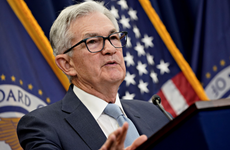More consumers are showing signs of financial distress

The Bankrate promise
At Bankrate we strive to help you make smarter financial decisions. While we adhere to strict , this post may contain references to products from our partners. Here's an explanation for . The content on this page is accurate as of the posting date; however, some of the offers mentioned may have expired. Terms apply to the offers listed on this page. Any opinions, analyses, reviews or recommendations expressed in this article are those of the author’s alone, and have not been reviewed, approved or otherwise endorsed by any card issuer.
Consumer spending has been remarkably resilient the past few years. In fact, it’s probably the biggest reason why we have yet to experience the long-awaited, much-forecast recession that has supposedly been right around the corner for about two years now.
But cracks in the foundation have begun to emerge, and they’re deepening, according to two of the nation’s largest nonprofit credit counseling agencies.
Young adults are feeling the biggest strain
Money Management International says 40 percent more clients sought its financial assistance this past August, compared with August of 2022. The biggest trouble spot appears to be young adults. MMI reports a 56 percent increase in the number of 18-29 year-olds contacting the agency since the start of the year.
“A balance that used to be manageable with lower interest rates is unmanageable now that rates are so high,” asserts Kate Bulger, a vice president at Money Management International. “For young people, this is often the first time they’ve ever experienced higher interest rates. While inflation has cooled, the cost of goods remains high, and salaries haven’t kept up.”
Further, the average MMI client’s debt load is 26 percent higher than a year ago. Credit card debt is a significant factor. The New York Fed recently reported that Americans’ total credit card balances crossed $1 trillion for the first time. From the second quarter of 2022 to the second quarter of 2023, that figure rose 16 percent.
Student loan payments are resuming at a bad time
Another major headwind is the fact that federal student loan payments are due this month for the first time since early 2020, while the Biden Administration’s broad-based forgiveness program was shot down by the Supreme Court.
GreenPath, another debt counseling service, estimates that 50 percent of its credit counseling clients were within $100 of a monthly budget deficit in August. “This number becomes starker as we dive further into clients who specifically have student loan debt,” explained Kathryn Ellywicz, a marketing and communications specialist at GreenPath. “From our data, we are seeing a significant concern for American budgets.”
The organization estimates that another 32 percent of its clients will be in a budget deficit now that the student loan moratorium has expired.
Liz Pagel, senior vice president of consumer lending at TransUnion, agrees: “Over the course of the student loan payment pause, many consumers who currently have student loans acquired new credit products, increasing their monthly payment obligations. For many consumers, their total monthly payments today, without student loan payments, exceed what they were paying in aggregate in 2020 prior to the pause. Adding the new payments to the mix will be a noticeable payment shock.”
The cumulative effect
Month after month of high inflation and rising interest rates have taken a significant toll on Americans’ finances. A recent Bankrate survey revealed that more people are carrying more credit card debt for longer periods of time.
For instance, 47 percent of credit cardholders carry balances from month to month, up from 39 percent two years ago. And 60 percent of these individuals with credit card debt have been in credit card debt for at least a year, up from 50 percent in 2021. Plus, the average credit card rate (20.72 percent) has never been higher.
Remember the $2 trillion in excess savings that Americans were said to have amassed early in the pandemic? That’s all but gone at this point, especially among lower- and middle-income households.
“We are paying attention to the lower FICO consumer, where there are cracks” forming, Citigroup CEO Jane Fraser told CNBC last week. “I think some of the excess savings from the COVID years are getting close to depletion.”
Bankrate’s annual emergency savings survey found that just 43 percent of U.S. adults would pay for a $1,000 emergency expense from their savings. A quarter (25 percent) of respondents said they would use a credit card and finance the purchase over time, the highest figure since polling began in 2014.
What you can do about it
If you’re worried about your finances, you’re certainly not alone. My top tip for credit card debt payoff is to sign up for a 0 percent balance transfer credit card. These allow you to move your existing high-cost credit card debt over to a new card with an interest-free term lasting as long as 21 months.
If you have a lower credit score (below, say, 670) or a lot of credit card debt (perhaps more than $5,000), then you’re an especially good candidate for nonprofit credit counseling. Agencies such as Money Management International and GreenPath can often negotiate better terms with your creditors and walk you through the debt payoff process. A common example might include something like a 6 or 7 percent interest rate over four or five years.
You might also consider taking on a side hustle to raise extra funds that you can put toward your debt. Other good tactics include selling stuff you don’t need and cutting your expenses. Make sure to set a realistic budget as well, accounting for the fact that many of your expenses may have changed in recent months, especially if you have student loans.
Here’s why it matters so much: The average credit card balance is $5,947, according to TransUnion. If you only make minimum payments at the average interest rate (20.72 percent), you’ll be in debt for more than 17 years and will owe about $8,800 in interest. Particularly when it comes to high-rate debt such as credit card debt, the more money you can funnel into these payoff efforts, the better.
Have a question about credit cards? E-mail me at ted.rossman@bankrate.com and I’d be happy to help.
Related Articles


Fed raises rates by quarter point, signals more increases on way to further bring down inflation

